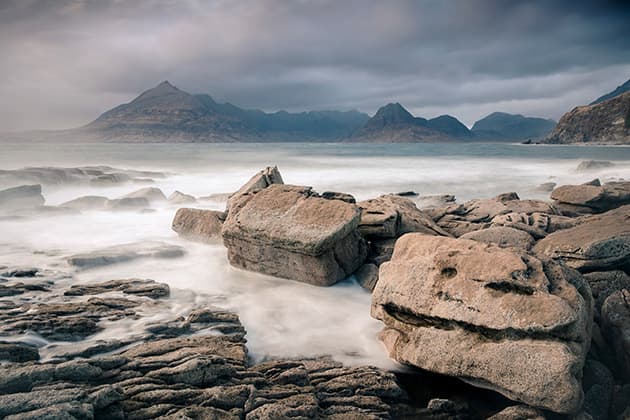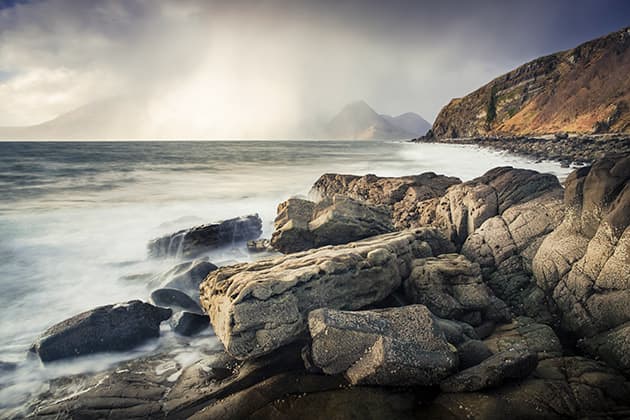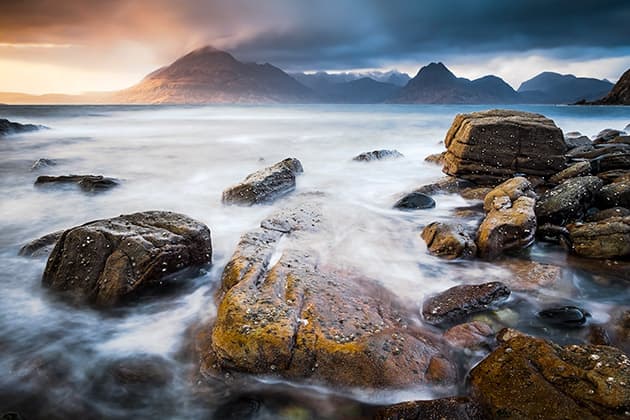The road from Broadford to Elgol on the Isle of Skye, Scotland, is littered with photo opportunities, and what should take about 35-40 minutes to travel the 15 or so miles to the coast can easily take you all day. However, the fabulous lochs of Cill Chriosd and Slapin are purely appetisers for what awaits at the end of the road.
A beach that faces west and is littered with an abundance of rocks is going to attract anyone with an interest in landscape photography, but throw in a backdrop of the staggeringly dramatic Cuillin Ridge, and the place becomes a bucket-list destination. For this reason the area within 200 metres from the pier can get crowded and is always a popular spot for workshops.
The beach heads north from the little car park towards a yellow overhanging cliff, after which it bends right. The majority of the interesting rocks can be found here, but take your time to explore, and try to anticipate new compositions as the tide gradually moves in or out.
Elgol isn’t just a one-trick pony. The clifftops south of the harbour offer a nice vista across Loch Scavaig, or follow the path south of the village and you will find a much quieter shore with some interesting rocks and that same dramatic backdrop.

I was on my way back to the car when I noticed the face in the rock. Fujifilm X-T2, 16-55mm, 6.5sec at f/10, ISO 100. Credit: Dave Fieldhouse
Shooting advice
When to go
Elgol can be photographed at any time of the year, but the location works best in the late afternoon or around sunset. Don’t be put off if epic light isn’t forecast – a cloudy day can still produce a moody image if your composition is strong enough.
Food and lodging
There are very few facilities at Elgol itself, especially out of season, so maybe take a snack and drink with you. The town of Broadford (15 miles from Elgol) has a good selection of places to eat and stay. Café Sia always has a great choice of coffee and cake, as well as handmade pizza and locally sourced wines.
Word of warning
As with any coastal location check the tide times before you go (it is unlikely you will pick up any 3G/4G signal here). This is a beach that is mostly rock. While the variety of rocks provides unlimited photographic potential, they can be very slippery when wet. I would advise you stow your camera gear safely in the bag as you traverse the shoreline.

If you don’t like the weather at Elgol wait five minutes and it will change. Fujifilm X-T2, 16-55mm, 3sec at f/11, ISO 100. Credit: Dave Fieldhouse
Kit list
- Tripod I like to play with varying exposure lengths when at the coast, but generally favouring a shutter speed of around one second to capture motion in the water. It would be impossible to hold a camera steady for this length of time, so I always use a tripod.
- Polariser filter Bright light on wet foreground rocks or rockpools can cause distractions, so consider using a polariser to reduce glare and enable the camera to see details beneath the surface.
- Lens cloth Spray from the waves will play havoc with your lenses and filters. Make sure you keep them as clean as possible. It will save you lots of time trying to remove spots during processing, which can sometimes spoil an entire set
of images.







